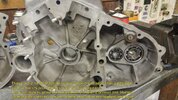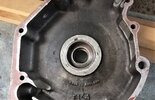You are using an out of date browser. It may not display this or other websites correctly.
You should upgrade or use an alternative browser.
You should upgrade or use an alternative browser.
ET: Engine (Twin) Installing ET92 Inner Roller Set on Mainshaft
- Thread starter craig
- Start date
So did Doug Hollis,but he used 3 screws.Rip Tragle used to do that, too.
The punch locking was only done in a light fashion to simply stop each bearing from falling out of the hot case when the case is flipped over to carry out work on the other side of the case........Not to hold the bearing firmly into the bore for each bearing. If the punch marks are done too heavily, you will deform the bearing directly where the punch marks are, and the inner will spin with a ratchet like action. The use of screws to secure the bearing is probably ok on a stock road engine, though it is something I don't do myself.......I've seen it done on a chopped race engine with absolute disastrous results, the drive side case split right through were these screws were used to anchor the bearing.......There were other reasons why this happened, but it still did it. I've only seen lipped bearings used on one engine i had here, and their use needs to be done very carefully.......as the width of the lip needs to be set up wide enough for the total width of the crank set up.......On this one, when the case halves were bolted up together, the crank would lock up.......So I heated the cases and replaced the bearings with normal rollers. The cases should be heated to around 170 to 180 degrees Celsius max......200 is too hot, this will anneal the alloy........Measure the housings accurately races should have 0.001" minimum interference........Most bearings measure 2.499" so housing should be 2.498" or slightly less........Good luck.
There are some assembling aspects to see if you fit lipped roller bearings , depending on where the roller set is located, in inner or outer race. Anyway, I have not found this punch lock thing on any continental engine, just poor engineering escape for need of better idea. How often can you do this till the engine looks shameful ?
I would never do the screw fix for fear of starting cracks in this highly loaded place, definitely. The less offensive idea is just a very easy hammering the edge of the bore down a bit towards the radiused race, in a few places around.
For working out shims on all shafts, crank included, I made POM dummy bearings, easy fit but with same width. So you can test assemble all shafts , one at each time , to get sizes for shims. So after you won´t have surprises when assembling the completed engine. This no different for ball or roller bearings, lipped or not.
Bearing shrink fits in case , no need to be excessive, I´d like them to get free at 100-120 degrees C. For assembling the engine you will not want to have more than 80 degrees so not an excuse for punch locks just because the bearings might drop out ? It is a good idea to calculate shrink fits for each size of bearing in percentage of nominal diameter for secure fit up to min. 80 degrees C . The cam spindles will have been fitted at this stage a while ago at 200 degrees, so no , no punch job then.
Well, I´d be ashamed as a mechanic to design something around punch locking to save my ass. A matter of attitude to your profession ?
Vic
I would never do the screw fix for fear of starting cracks in this highly loaded place, definitely. The less offensive idea is just a very easy hammering the edge of the bore down a bit towards the radiused race, in a few places around.
For working out shims on all shafts, crank included, I made POM dummy bearings, easy fit but with same width. So you can test assemble all shafts , one at each time , to get sizes for shims. So after you won´t have surprises when assembling the completed engine. This no different for ball or roller bearings, lipped or not.
Bearing shrink fits in case , no need to be excessive, I´d like them to get free at 100-120 degrees C. For assembling the engine you will not want to have more than 80 degrees so not an excuse for punch locks just because the bearings might drop out ? It is a good idea to calculate shrink fits for each size of bearing in percentage of nominal diameter for secure fit up to min. 80 degrees C . The cam spindles will have been fitted at this stage a while ago at 200 degrees, so no , no punch job then.
Well, I´d be ashamed as a mechanic to design something around punch locking to save my ass. A matter of attitude to your profession ?
Vic
Well the practice of punch locking or penning over things is typically British.........I don't particularly like it for the reasons Vic is expressing, but the thing is that this method is really aimed at "single use".......in the case of aircraft bolts used on many British built planes, the excess thread is cut off just proud of the plain nut, then the edge of the bolt is penned over whilst a Dolly is held against the head of the bolt.......Once removed for whatever reason the bolts/nuts are discarded and then replaced with new........this is just an example of how these things were done........Some cases have suffered terrible abuse from some who don't care for anything least an old bike. Vic most all of your mods are very well done, some are complete overkill.........most folk simply don't have the skill or funds/time to pay someone to carry out what you have done. I work on these bikes near full time and some jobs are a real struggle to fix, especially complex machining jobs that take a long time to get done........everyone who has these kind of skills are very busy these days........getting someone to spend precious time repairing damaged cases or similar is very difficult.
I do not do staking, but I think there might be some misunderstanding. I believe that the four stakes on each journal were made in order to continue assembling bearings in the cases after the races were installed and the cases were still hot. This way, the races would stay in position temporarily while continuing to build the crankcases. Much like the cylinder muff, care must be taken to keep the muff in position while the assembly cools down. I suspect that the stakes were not intended to retain the race in the case in lieu of a proper interference fit.
I think there are much better procedures (mentioned above and elsewhere) for the owner/rider to use rather than resorting to the repeated use of staking. But I do think the stakes were intended to do a very small job.
David
I think there are much better procedures (mentioned above and elsewhere) for the owner/rider to use rather than resorting to the repeated use of staking. But I do think the stakes were intended to do a very small job.
David
Page 62 of the "Instruction Sheets" has notable instructions on this main bearing fitment.
I placed the drive side case at the floor discharge of shop wall heater and got the case to 130F.
With tools I showed earlier in post 38, three pound hammer and a modified punch, I struck 4 new stake positions and satisfied I assembled the drive side with ease.
I placed the drive side case at the floor discharge of shop wall heater and got the case to 130F.
With tools I showed earlier in post 38, three pound hammer and a modified punch, I struck 4 new stake positions and satisfied I assembled the drive side with ease.
Last edited:
I can imagine the Phils had afterthoughts about plain races walking in the case and finally grinding on the big end nut. In many engines from all brands you can expect some amount of walking bearings, depending on perfect fits from start. So the staking was most likely a safety operation. I am not so familiar with roller bearings of the type with rollers contained on inner race. Not often found here as I think handling is easier with rollers in outer race. One has to remember the times when Vincent bikes were produced and what was available then, so this must have had some meaning in the design of components . When I looked for imperial roller bearings some years ago I got the idea that they are hard to find with rollers in outer race plus lipped type. So this was not my choice and went for all metric with the homemade crank. One good argument was the o.d. of the modern bearing is 62 mm with 30 mm i.d. so this would be suitable in an engine overhaul for a new alu bush in the worn 63.5mm bore without weakening the case from boring oversize for a substantial bush towards original 63.5mm size. The mainshaft is 1 " standard and you could do a simple bush loctited on the mainshaft for 30 mm with the metric type with a lot higher load factor -and available in all sorts of types. But yes, I am a retired toolmaker waisting all my own time on playing with machine tools to my likings, no way can you charge a customer for all that time spent on his bike - unless he just wants it.
In these times it has become very difficult to find companies agreeing on that kind of job. Most of them got high output productions so no desire to do complicated machining at modest costs. I was thinking about Kiwis and Aussies to have the can-do attitude saved into this millennium , traditionally challenged by lengthy import supplies so you better try to do it by yourself. As can be seen attitudes to "dirty" work have become international in younger people who prefer "cool" jobs with high pay supposedly . So seeing this makes me feel really old and fallen out of time . Allright, there are exceptions I know who like to mess around with old motorbikes but it does not help in finding skilled mechanics in companies when you need them. So best you spend loads of cash into machinery and do it all to yourself . . .
Vic
In these times it has become very difficult to find companies agreeing on that kind of job. Most of them got high output productions so no desire to do complicated machining at modest costs. I was thinking about Kiwis and Aussies to have the can-do attitude saved into this millennium , traditionally challenged by lengthy import supplies so you better try to do it by yourself. As can be seen attitudes to "dirty" work have become international in younger people who prefer "cool" jobs with high pay supposedly . So seeing this makes me feel really old and fallen out of time . Allright, there are exceptions I know who like to mess around with old motorbikes but it does not help in finding skilled mechanics in companies when you need them. So best you spend loads of cash into machinery and do it all to yourself . . .
Vic


